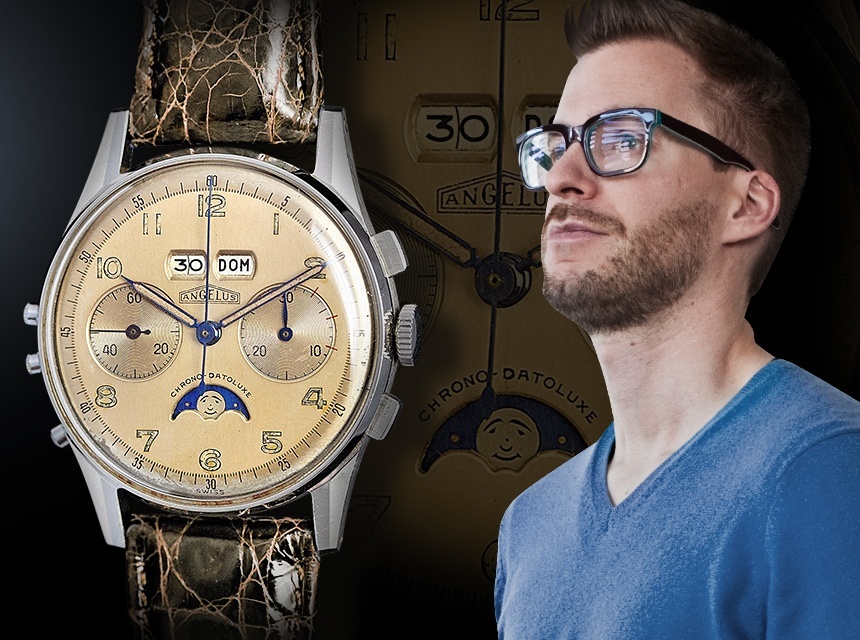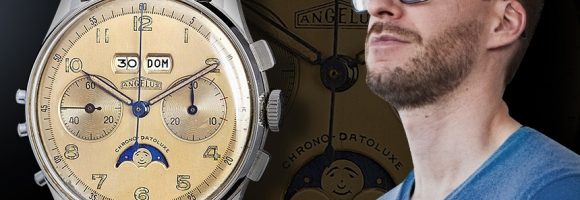A followup to the Tourbillon Chronometer No. 36 declared during Baselworld 2017, this new version presents dark gray and rose gold tones which serve to enhance the visual beauty and complexity of a watch that showcases the newest technical art. More importantly, the watch comes with a new stainless steel case with anthracite DLC coating to attain the pronounced gunmetal look. Though the inspiration for the watch is arguably among the most important classical timepieces from the new history, this model is far more modern in its execution and design.The original “Arnold 36” chronometer wasn’t just the initial pocket watch by John Arnold to utilize a bigger movement with the “T” equilibrium, but also the first to be called a “chronometer” because of its exceptional timekeeping capabilities. This was, of course, prior to the COSC affiliation that phrase is well known for today. Rather than fully replicate the piece visually, however, Arnold & Son has created something spectacular and modern with a movement that essentially takes place of the dial completely. Aside from the Arnold 36 chronometer, Arnold & Son is also paying tribute to the older English gunsmith convention, which is closely related to traditional watchmaking and shares many common methods.
Once set, the precision should hold for 122 decades, and an easy adjustment will ensure it for another 122 decades. The hand-wound movement is an Arnold & Son manufacture A&S1512 that beats at 21,600 bph using a 90-hour power reserve. As if the case back were not beautiful enough, the C?tes de Genève shown throughout the movement is just lovely.The Arnold & Son HM Dual Hemisphere Perpetual Moon comes with either a black or brownish hand-stitched alligator strap and is guaranteed to catch the attention of many a watch buff. The Arnold & Son HM Dual Hemisphere Perpetual Moon watch is priced at $30,500. When trying to fix a problem, the start is always a fantastic place to start. That is precisely the procedure followed by Arnold & Son in their endeavor to eliminate isochronal error from among the newest bits, the Arnold & Son Continuous Force Tourbillon. Arnold & Son’s heritage is present in the heritage of John Arnold and his son, two of the greatest watchmakers to come from England. Having packed off his son to learn in the back of the Swiss maestro, Arnold turned his attentions to the problem of these times: the pursuit for chronometric accuracy at sea.

Welcome back to an original aBlogtoWatch feature, “My First Grail Watch.” In this series, we ask prominent people in the watch industry about the first timepiece that they lusted after. Today, we’re speaking with Sebastien Chaulmontet, who heads the movement team at Arnold & Son. You’ll also note that he’s an avid collector enamored with chronographs, just like many of us.
At 12 o’clock is a day/night indicator for both GMT time and home time, using matching skeletonized and stuffed palms to tell them apart. The bottom half of the indicator is darkened, which aids the visual representation of the “nighttime” part of this disk. I really do wish the Arnold & Son logo was located elsewhere however, as its place interrupting the moments monitor at 12 o’clock could make exact time-setting difficult. Another niggling issue I discovered was that the next hand counterweight closely emulates the look of the home time palms, which can sometimes cause a moment of confusion when you glance down and watch three hands pointing at that dial. In an perfect world, I would have loved to see the minute hands on each dial stretched just a bit further to correctly get to the minute track, along with the hour hands shortened a tad to not overlap the hour mark, but that is a little aesthetic qualm which doesn’t impact utility.On the reverse side of this Arnold & Son DBG Skeleton, the bottom plate of this manufacture bore A&S1309 is revealed. The motion is made from nickel silver (also called German silver or Maillechort, an alloy of aluminum, nickel and zinc) that has been rhodium-plated and embellished with C?tes de Genève. The wheels are satin-finished and provide a contrasting three dimensional texture into the base plate, and between the chamfered edges of these bridges, the golden gear train could be viewed. The movement is hand wound of course, which contributes to its thinness in a mere 3.9mm. It features 42 jewels and offers a 40 hour power reserve while the double balances oscillate at 21,600vph, or 3Hz. That is definitely a highly refined motion, but in contrast to the thickness of detail offered by this skeletonized dial, the reverse side of the movement almost feels like a letdown.
aBlogtoWatch (ABTW): Who are you, and what is your relationship to the watch industry?
Sebastien Chaulmontet (SC): I am head of movement development at Arnold & Son, and I am also part of the design team.
ABTW: When did your fascination with watches start?
Sebastien Chaulmontet: As a child; I was 10 years old. I bought my first vintage watch (a simple ladies’ Omega) at a flea market. I wanted to give it to my mother for her birthday. It cost me 10 CHF at the time (around USD 10) and I still remember the day and place where I bought it. My mother still has the watch today and she remembers fondly that I bought my first watch for her.
ABTW: That’s a great bit of family history there. Let’s turn the focus more towards your collection – what was your first grail watch?
One of the greatest issues when it comes to precision is moderating the supply of electricity to the regulating organ of the timepiece (in this case, the tourbillon featured at the lower right quadrant of the dial). The mainspring, for example every component of this size, is vulnerable to certain molecular inconsistencies acquired during the creation procedure. Any internal or external inconsistency could lead to a fluctuation of power delivered into the gear train. And that is before one even considers the extreme drop-off in torque once the mainspring satisfactorily uncoils. As the mainspring winds down, the total amount of power delivered into the escapement dips. This can potentially play havoc with the timekeeping, so Arnold & Son have tried to remove this error by installing a “constant-force” mechanism. The modern incarnation of the business that lay dormant for over a century is doing what it is to reconnect with the source of its inspiration.Practically speaking, this component takes the location of a fuseé, which is an age-old continuous force complication we have seen on aBlogtoWatch very recently in the new Zenith Academy Georges Favre-Jacot Anniversary piece (read the review here), for example. To compensate for the inevitable drop-off in electricity generated with a single barrel at a standard set-up, Arnold & Son have started out with two gaseous barrels in string. The first barrel forces the equipment train, while the second barrel tops up the torque of the first if it drops below an optimal level. But their invention does not stop there.
Sebastien Chaulmontet: I had been searching for years for a vintage Angelus Chrono-datoluxe, the first ever chronograph with a big date.
ABTW: What drew you to this particular watch?
Sebastien Chaulmontet: I am a chronograph collector and I have always been attracted to Angelus as it was a real manufacture. This watch is particularly rare and a must-have for any chronograph collector.
Though the contemporary Arnold & Son is currently owned by the Citizen Group and continues to be revived in La Chaux-de-Fonds, Switzerland, the legacy of precision timekeeping, progress in escapement technology, and Breguet’s influence can nevertheless be felt with this timepiece. The Arnold & Son DBG Skeleton basically combines two motions, each using their own barrel, gear train, escapement, and balance, combined with a single winding system and a single centralized second hand. Both dials for home time and GMT are powered with their own dedicated motions, permitting each to be placed independently via a dual crown system at 3 and 9 o’clock. Coolness factor aside, this also has a practical advantage in being able to place GMT time into the moment, which can be particularly beneficial when dealing with time zones cancel by 30 minutes such as parts of India, Australia, and Canada.In contrast to the non-skeletonized variant of this Arnold & Son DBG we analyzed before, this incarnation sacrifices some legibility in order to better display that beautifully symmetrical movement. A ring of smoked sapphire crystal glass is used for each dial to help bring the numerals more into focus against the busy backdrop without completely obscuring it, which is a smart move. GMT time can also be differentiated via the dial’s use of skeletonized hands and Roman numerals, compared to the Arabic numerals and solid hands featured on the house time dial. Unlike the last version, the hands on the Arnold & Son DBG Skeleton are gilded instead of blued, which is visually a nice complement to the vulnerable equilibrium wheels but also makes them difficult to view at a glance.
ABTW: Was there ever a time in your life when you could afford it – and if so, did you get it?
Sebastien Chaulmontet: Yes, absolutely, I could and did buy it. I even bought some additional versions later on.
ABTW: Do you still have it, or have you moved on to something else?
Sebastien Chaulmontet: Of course, I still have it as part of my collection. As a collector the search/quest never ends, and I continue to collect other vintage chronographs.
